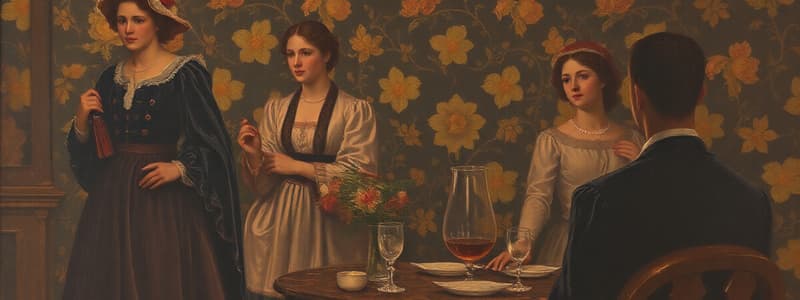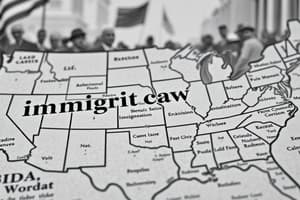Podcast
Questions and Answers
Who was the Republican candidate elected into office in 1920 with the largest majority in American history?
Who was the Republican candidate elected into office in 1920 with the largest majority in American history?
- Herbert Hoover
- Warren Harding (correct)
- Calvin Coolidge
- Silent Cal
The rise of immigration in the 1920s had no cultural impact on America.
The rise of immigration in the 1920s had no cultural impact on America.
False (B)
What was the Fordney-McCumber Tariff designed to encourage?
What was the Fordney-McCumber Tariff designed to encourage?
To encourage Americans to buy American goods.
In the 1920s, the cost of a Model T Ford dropped to about ___ dollars.
In the 1920s, the cost of a Model T Ford dropped to about ___ dollars.
Match the terms with their correct definitions:
Match the terms with their correct definitions:
What devastating economic event occurred in 1929?
What devastating economic event occurred in 1929?
Al Capone was known as the most famous gangster of the Prohibition era.
Al Capone was known as the most famous gangster of the Prohibition era.
What was the impact of the cycle of prosperity in the 1920s?
What was the impact of the cycle of prosperity in the 1920s?
The law that enforced racial segregation was known as the ___ Laws.
The law that enforced racial segregation was known as the ___ Laws.
What year did women in the US gain the right to vote?
What year did women in the US gain the right to vote?
Flashcards
1920s Republican President
1920s Republican President
Warren Harding was the Republican president elected in 1920 with a large majority.
US Isolationism
US Isolationism
A policy keeping the US out of European conflicts.
Fordney-McCumber Tariff
Fordney-McCumber Tariff
A tax on European imports to protect US businesses.
Automobile Industry Boom
Automobile Industry Boom
Signup and view all the flashcards
Flappers
Flappers
Signup and view all the flashcards
Prohibition
Prohibition
Signup and view all the flashcards
Wall Street Crash
Wall Street Crash
Signup and view all the flashcards
Jim Crow Laws
Jim Crow Laws
Signup and view all the flashcards
Model T Ford Price Drop
Model T Ford Price Drop
Signup and view all the flashcards
The Great Depression Height
The Great Depression Height
Signup and view all the flashcards
Study Notes
1920s USA
- President: Warren Harding was elected president in 1920 with 61% of the vote.
- Isolationism: Policy to stay out of European affairs.
- Immigration Impact: Immigration increased cultural diversity but also caused social tensions.
- Fordney-McCumber Tariff: High taxes on European imports; aimed to protect American businesses.
- Auto Industry: Henry Ford's assembly line increased car production, putting more cars on the road.
- Prosperity Cycle: Economic prosperity was driven by increased automobile production, and consumer spending which created many jobs.
- Model T Ford Cost: Model T Ford prices dropped dramatically by the early 1920s due to increased production.
- Flappers: Young middle-class women who broke from traditional norms in the 1920s.
- Josephine Baker: First Black American woman starring in an American film.
- Prohibition: Banned the manufacture, sale, and consumption of alcohol.
- Speakeasies: Illegal bars that served alcohol during prohibition.
- Bootleggers: Individuals who illegally transported and sold alcohol.
- Al Capone: Famous gangster during Prohibition.
- Ku Klux Klan: Group that promoted intolerance and fear in the 1920s.
- Jim Crow Laws: State and local laws that enforced racial segregation.
- Wall Street Crash: A devastating economic event in 1929.
- Wall Street Trading: 13 million shares were traded on Wall Street on one day in October 1929 during the stock market crash.
- Great Depression: Height of the economic crisis was in 1933.
Additional Information
- American Manufacturing: American people were encouraged to buy American goods.
- Jobs Created: The auto industry and other multiple industries created many jobs.
- (Approximate Number of Cars in 1920s): Over 1 million
- (Approximate Number of jobs in industry): About 5300.
Studying That Suits You
Use AI to generate personalized quizzes and flashcards to suit your learning preferences.




